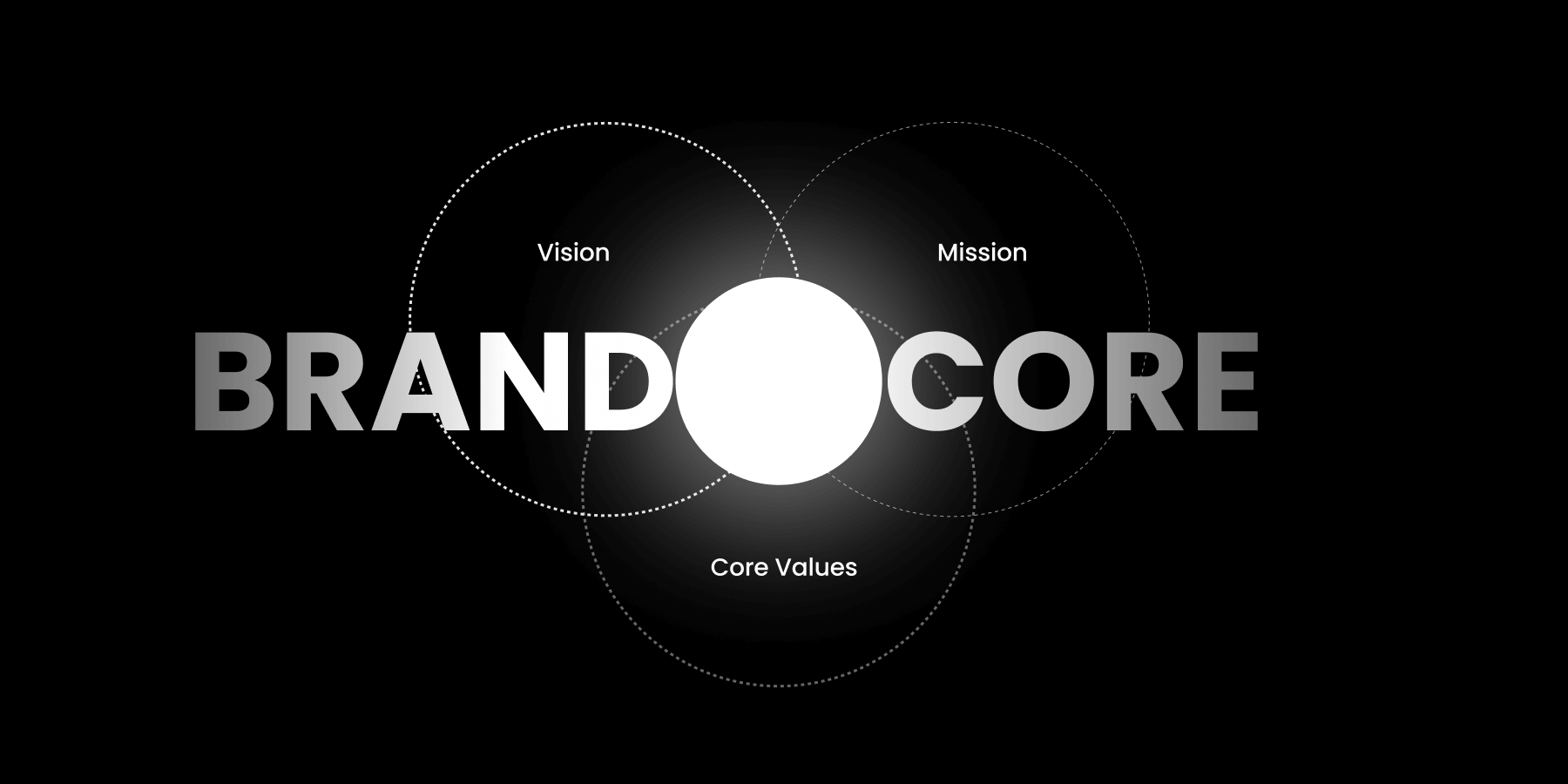Brand Core – The Vision, Mission, and Values
Brand Design, Business, Education . June 21, 2024 .17 Min Read
What is in it for you?
By reading this blog, you will understand the roles of mission, vision, and values in the planning process. You will also learn how mission and vision fit into the planning-organizing-leading-controlling (P-O-L-C) framework. Additionally, you will see how creativity and passion relate to vision. Moreover, you will be able to develop statements that articulate organizational mission and vision.
Planning | Organizing | Leading | Controlling |
|---|---|---|---|
|
|
|
|
POLC Framework
Purpose of Vision, Mission, and Values
- Mission and vision statements communicate an organization’s purpose and are typically expressed in written form.
- “Mission and vision” are not just statements; they are the guiding principles organizations use to define their purpose, set their goals, and aspire to a better future.
- who we are,
- what do we value, and
- where we’re going.
- Values are the beliefs in which an individual or group, in this case the organization, is emotionally invested.
- Create a positive work environment where everyone is treated with respect and dignity.
- Embrace diversity as an essential component of our business practices.
- Roles Played by Mission and Vision
- Mission and vision statements play three critical roles:
- communicate the purpose of the organization to stakeholders,
- inform strategy development and
- develop the measurable goals and objectives by which to gauge the success of the organization’s strategy
- Mission and vision statements play three critical roles:
First, mission and vision provide a vehicle for communicating an organization’s purpose and values to all key stakeholders. Stakeholders are those key parties who have some influence over the organization or stake in its future. Typically, these statements would be widely circulated and discussed often so that their meaning is widely understood, shared, and internalized. The better employees understand an organization’s purpose, mission, and vision, the better they will understand the strategy and its implementation.
Second, mission and vision create a target for strategy development. One criterion of a good strategy is how well it helps the firm achieve its mission and vision. To better understand the relationship among mission, vision, and strategy, it is helpful to visualize them collectively as a funnel. You find the inputs into the mission statement at the broadest part of the funnel. Toward the narrower part of the funnel, you see the vision statement, which has distilled down the mission so that it can guide the development of the strategy. In the narrowest part of the funnel, you find the strategy clear and explicit about what the firm will do and not do to achieve the vision. Vision statements also provide a bridge between the mission and the strategy. In that sense, the best vision statements create tension and restlessness about the status quo—that is, they should foster a spirit of continuous innovation and improvement.
Thirdly, mission and vision act as a guiding light, while the strategy provides a detailed roadmap for the goals and objectives that determine the success or failure of the strategy and the fulfillment of the broader set of objectives outlined in the mission. In the case of both Starbucks and Toyota, one would expect to see goals related to profitability, along with metrics on customer and employee satisfaction, and social and environmental responsibility. These goals, set at different levels, reflect the mission’s and vision’s comprehensive nature and the strategy’s role in achieving them.
In addition to linking mission and vision to strategy, goals, and objectives, you should also expect to see them connected to the organizing, leading, and controlling aspects. Let’s consider each of these areas in detail.
- Understand the role of mission and vision in organizing.
- Organizing is the function of management that involves developing an organizational structure and allocating human resources to ensure the accomplishment of objectives.
- Organizational design is a formal, guided process for integrating an organization’s people, information, and technology. Its purpose is to match the organization’s form as closely as possible to its purpose(s). Through the design process, organizations improve the probability that their members’ collective efforts will be successful.
- For example, in 2006, Disney acquired Pixar, a renowned firm for its creative prowess in animated entertainment. Disney summarizes the Pixar strategy as follows: “Pixar’s [approach] is to combine proprietary technology and world-class creative talent to develop computer-animated feature films with memorable characters and heartwarming stories that appeal to audiences of all ages. Disney has helped Pixar achieve this strategy by combining structural design choices. First, Pixar is an independent division of Disney and is empowered to make independent choices in all aspects of idea development.
- Second, Pixar gives its “creatives”—artists, writers, and designers—significant leeway over decision-making.
- Third, Pixar protects its creatives’ ability to share work in progress, up and down the hierarchy, to improve it. Finally, teams conduct “postmortems” after each project to catalog what went right and wrong. This way, innovations gained through new projects can be shared with later projects.
- Organizational culture is the environment in which employees work, shaped by their interactions with each other. It is a result of their life experiences, education, strengths, weaknesses, and other attributes. Although executive leaders have a significant influence on the company’s culture through their actions and leadership, every employee contributes to it. When mission and vision align with the organizational culture, it can be a powerful force, but changing the culture can be a daunting task. If you plan on changing the company’s vision or mission, changing the organizational culture may take a while to support these new directions.
- Social networks are often referred to as the “invisible organization” because they are made up of individuals or organizations that are linked by one or more specific types of interdependence. Although you may already be active on social networks through sites like Facebook, LinkedIn, or MySpace, these sites only scratch the surface of what social networks have to offer. Networks deliver three unique advantages: access to “private” information (i.e., information that companies do not want competitors to have), access to diverse skill sets, and power. Many large companies struggle with communication breakdowns even within divisions where work on one project should be related to work on another. For example, Disney is fostering a network among members of its Pixar division in a way that encourages information sharing and learning from others. The open internal network also means that a cartoon designer might have easier access to a computer programmer, and together, they can figure out a more innovative solution. Finally, since Pixar promotes communication across hierarchical levels and gives creatives decision-making authority, the typical power struggles that might impede sharing innovation and individual creativity are prevented. Managers see these three network advantages at work daily but might not pause to consider how their networks regulate them.
- Understand the role of mission and vision in leading.
- Leading refers to the act of influencing others towards achieving organizational goals and objectives. Eight Principles of Visionary Leadership
- Principle 1: The visionary leader must conduct on-site observation, which leads to a personal perception of changes in societal values from an outsider’s point of view.
- Principle 2: Even though there is resistance, never give up; squeeze the resistance between outside-in (i.e., customer or society-led) pressure in combination with top-down inside instruction.
- Principle 3: Revolution begins with the symbolic disruption of the old or traditional system through top-down efforts to create chaos within the organization.
- Principle 4: A symbolically visible image and the visionary leader’s symbolic behavior illustrate the revolution’s direction.
- Principle 5: Quickly establishing new physical, organizational, and behavioral systems is essential for a successful revolution.
- Principle 6: Real change leaders are necessary to enable revolution.
- Principle 7: Create an innovative system to provide feedback on results.
- Principle 8: Create a daily operation system, including a new work structure, a new approach to human capabilities, and improvement activities.
- Leading refers to the act of influencing others towards achieving organizational goals and objectives. Eight Principles of Visionary Leadership
- Understand the role of mission and vision in controlling.
- Controlling involves ensuring that performance does not deviate from standards. Controlling consists of three steps:
- (1) establishing performance standards,
- (2) comparing actual performance against standards, and
- (3) taking corrective action when necessary.
Mission and vision are both directly and indirectly related to all three steps.
- Strategic human resources management (SHRM) involves integrating an organization’s human capital, in other words, its people, into its mission and vision. Human resources management alignment means aligning decisions about people with the results the organization is trying to achieve. Studies indicate that organizations that successfully align human resources management with mission and vision achievement do so by integrating SHRM into the planning process, prioritizing human resources activities that support mission objectives, and developing strong human resources/management capabilities and relationships.
- Controlling involves ensuring that performance does not deviate from standards. Controlling consists of three steps:
Difference Between Vision and Mission Statement
| Vision Statement | Mission Statement |
|---|---|
A vision statement, in contrast, is a future-oriented declaration of the organization’s purpose and aspirations. | It is present-oriented, describing the organization's current purpose and primary objectives. It addresses what the organization does, for whom, and how. |
How creativity and passion relate to vision
Creativity and passion play a crucial role in crafting compelling mission and vision statements.
- Creativity can be defined as the ability to invent or generate new ideas. While we often associate creativity with art, it is also a key driver of innovation and progress in business.
- On the other hand, passion refers to an intense and overwhelming feeling or conviction associated with strong emotional impulses and a strong drive to take action.
Creativity and Vision
The book titled “Creativity at Work: Developing the Right Practices to Make It Happen” proposes a typology of creativity where different types of creative people can be identified based on their level of flexibility versus control and their internal versus external orientation. This categorization can be especially helpful for managers who are looking to foster creativity in their teams. The research suggests that there are 4 types of creativity, as shown in the figure. This information can help managers to understand better how to manage creative individuals and teams.
(1) investment (external orientation with high control),
(2) imagination (external orientation with flexibility emphasis),
(3) improvement (internal orientation with high control), and
(4) incubation (internal orientation with flexibility emphasis).
Passion and Vision
Passion is relevant to the vision in 2 ways:
- As the inspiration behind the vision and its statement, and
- through shared passion among members for the vision’s importance.
Crafting Vision and Mission Statements
The actual step-by-step process of developing a mission and vision might start with the mission and vision statements, but you should think of this process more broadly in terms of multiple steps:
- the process,
- the content of the mission and vision statements,
- communicating mission and vision to all relevant stakeholders, and
- monitoring.
Let’s dive into the development process first.
Process, Content, Application, and Monitoring in Mission and Vision Development. |
|---|
Process
|
Content
|
Communications
|
Application
|
Monitoring
|
Mission and Vision-Development Process
Developing a mission and vision statement is similar to the planning stage in the P-O-L-C framework. It is essential to involve the people who will be responsible for executing the mission and vision as much as possible. This can be done by soliciting their input and guiding them through the development of the statements or, ideally, by teaching them how to craft these statements themselves. It is crucial to involve as many key stakeholders as possible in the development process to ensure that they feel ownership of the statements. Each person, including each stakeholder, should be assigned responsibility and be clear on how they can contribute to the development process.
Content
The mission and vision statements of a company are similar to the organizing part of the P-O-L-C framework. To create these statements, begin by envisioning the best possible business future for your company, with a target of five to ten years in the future. Your goals should be ambitious but achievable. Jim Collins, the author of Good to Great, recommends setting a very bold vision, which he calls a BHAG26, or a big, hairy, audacious goal. Specifically, the O’Hallarons find that the best mission statements have given attention to the following six areas:
- What “want-satisfying” service or commodity do we produce and work constantly to improve?
- How do we increase the wealth or quality of life or society?
- How do we provide opportunities for the productive employment of people?
- How are we creating a high-quality and meaningful work experience for employees?
- How do we live up to the obligation to provide fair and just wages?
- How do we fulfill the obligation to provide a fair and just return on capital?
Tip: When crafting a statement for your business, use the present tense and write as if your company has already achieved what you are describing. Use descriptive language that appeals to all of the senses, explaining how your business looks, feels and operates. Your words should be a source of motivation and inspiration for where your organization is headed. Mission statements are typically longer than vision statements since they cover more ground, but try to keep it to a single page. You can use as many words as you like, but a shorter vision statement is more memorable.
Communications
The communications step of the development of the mission and vision statements is analogous to the “L” (leading) part of the P-O-L-C framework. Communicate often: Internal communications are the key to success. People need to see the vision, identify with it, and know that leadership is serious about it.
Managers must evaluate both the need and the necessary tactics for persuasively communicating a strategy in four different directions: upward, downward, across, and outward.
- Communicating Upward: Increasingly, firms rely on bottom-up innovation processes that encourage and empower middle-level and division managers to take ownership of their mission and vision and propose new strategies to achieve them. Communicating upward means that someone or some group has championed the vision internally and has succeeded in convincing top management of its merits and feasibility.
- Communicating Downward: Communicating downward means enlisting the support of the people who will be needed to implement the mission and vision. Too often, managers undertake this task only after a strategy has been set in stone, thereby running the risk of undermining both the strategy and any culture of trust and cooperation that may have existed previously. Starting the communication process early is the best way to identify and surmount obstacles, and it usually ensures that a management team is working with a common purpose and intensity that will be important when it’s time to implement the strategy.
- Communicating Across and Outward: The need to communicate across and outward reflects the fact that the realization of a mission and vision will probably require cooperation from other units of the firm (across) and key external stakeholders, such as material and capital providers, complementors, and customers (outward). Internally, for example, the strategy may call for raw materials or services to be provided by another subsidiary; perhaps it depends on sales leads from other units. The software company Emageon couldn’t get hospitals to adopt the leading-edge visualization software that was produced and sold by one subsidiary until its hardware division started cross-selling the software as well. This internal coordination required a champion from the software side to convince managers on the hardware side of the need and benefits of working together.
Application
Most organizations elude the successful execution of this step—actually using the mission and vision information. “Yes, it is inconvenient and expensive to move beyond the easy path” and make decisions that support the mission statement. Writing a Mission Statement That Your Company Is Willing to Live. Boston: Harvard Business School Press. That is not to say that a mission statement is written in stone.
“Mission statements are tools, and tools can be used or abused or ignored….Management must lead by example. It’s the only way employees can live up to the company’s mission statement.
Monitoring
The monitoring step of the mission and vision statements development process is analogous to the “C” (controlling) part of the P-O-L-C framework. Identify critical milestones that are implied or explicit in the mission and vision. Since mission and vision act like a compass for a long trip to a new land, as Information Week’s Hajela suggests, “While traveling to your destination, acknowledge the milestones along the way. With these milestones, you can monitor your progress: A strategic audit, combined with key metrics, can be used to measure progress against goals and objectives.
Conclusion
The blog emphasizes the crucial role that mission, vision, and values statements play in guiding an organization’s purpose, direction, and culture. It highlights the importance of aligning these statements with the organization’s strategic goals and ensuring that they resonate with all stakeholders. Crafting a clear and inspiring mission statement helps employees understand why the organization exists. In contrast, a well-defined vision statement paints a picture of the future that the organization aims to achieve. Values serve as guiding principles that shape behavior and decision-making. Together, these elements create a framework that drives organizational success and fosters a strong sense of identity and belonging among stakeholders. Developing a mission, vision, and values is not a one-time exercise but an ongoing process that requires regular review and refinement to ensure relevance and alignment with the organization’s and its stakeholders’ evolving needs.



